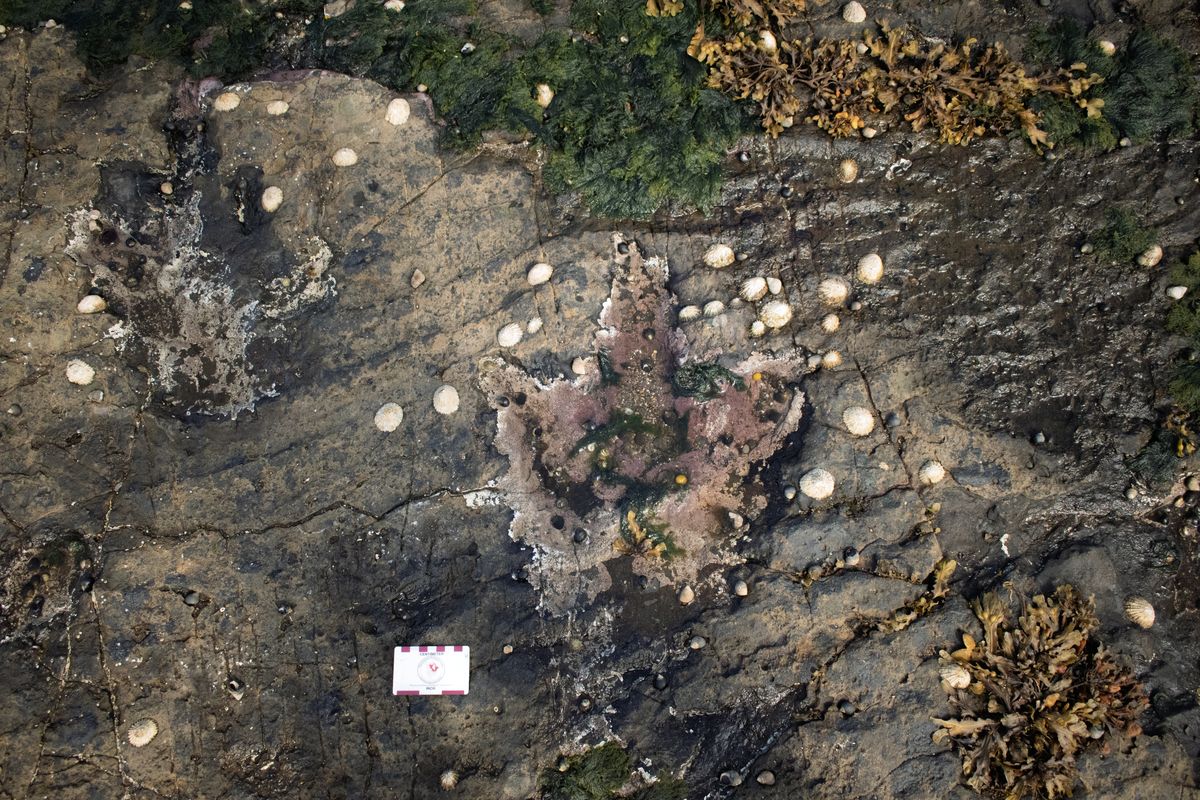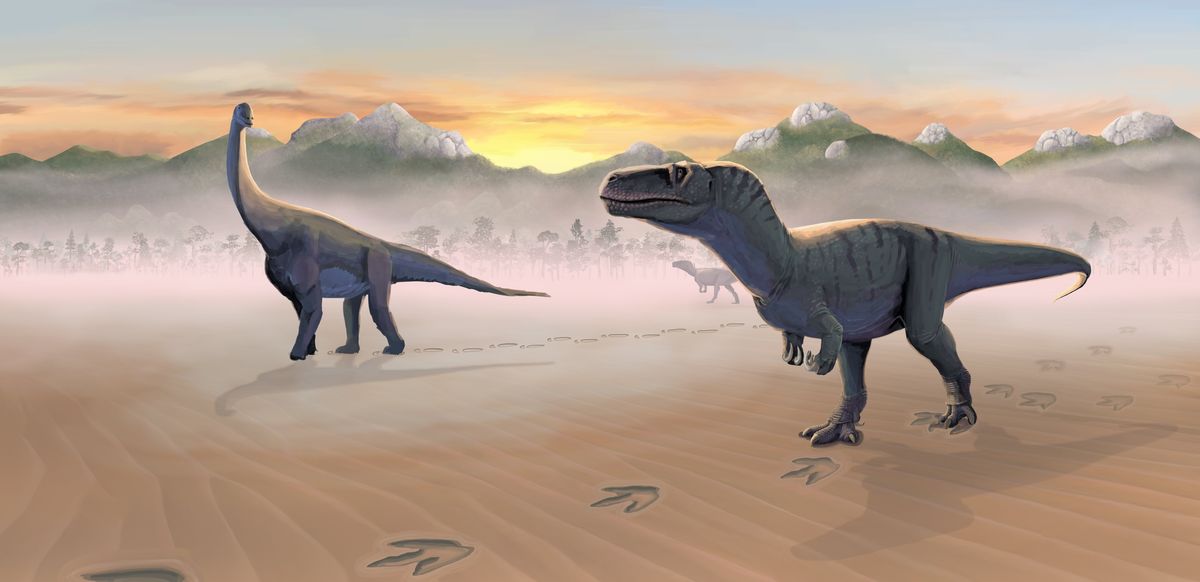Footprints show carnivorous dinosaurs shared watering hole with prey
A pair of theropod footprints at Prince Charles's Point, Isle of Skye, as seen in 2021. MUST CREDIT: PAIGE E. dePolo (Paige E. dePolo/Paige E. dePolo)
Lumbering, long-necked dinosaurs frequented the same watering hole as their predators some 167 million years ago, a scientific study of dinosaur footprints found.
The footprints at what is now the Isle of Skye, off Scotland’s north coast, revealed the existence of a popular stamping ground for dinosaurs, with evidence of both carnivores and herbivores “milling” about in the area and its prehistoric lagoons, said the peer-reviewed study, which was published Wednesday in the journal PLOS One.
Even though the slow-moving herbivores were likely prey for the smaller, sharp-toothed carnivores, said Tone Blakesley, the study’s lead author, the footprints show that they harmoniously shared the same freshwater lagoons.
“It was kind of the service station for the Middle Jurassic,” Blakesley said. “The dinosaurs would have come down from the surrounding land masses, drop down for a drink, move on. This was very much a transient spot.”
The footprints at Prince Charles’ Point, on the island’s northern peninsula, were first discovered in 2019 by a local couple who had observed some odd impressions while kayaking along the shoreline. Blakesley, who had just finished his freshman year at the time, inspected the area at the couple’s behest and found a three-toed dinosaur footprint in the sandstone.
“It was slightly raised and looked weathered, but it was really crisp and sharp,” Blakesley said. “You could see the toes, the claw marks.”
In the years that followed, Blakesley and researchers with the University of Edinburgh uncovered dozens more footprints in the area – he estimated between 150 and 200 – and analyzed 131 for their study. They determined that some of the prints, like the first three-toed one that Blakesley uncovered, were made by carnivore theropods, likely Megalosauruses, an ancestor of the formidable Tyrannosaurus rex. Other rounded prints were likely made by herbivore sauropods like the Cetiosaurus, the precursor to the brontosaurus.
From the footprints, which ranged in 9.8 to 23.6 inches in length, the researchers were able to estimate the dinosaurs’ hip height and length of strides. The three-toed theropods were likely about the size of a jeep, Blakesley said, and moved at what humans would consider a jog, about 5 miles per hour. The large sauropods were likely the height of two to three elephants and moved at half the walking speed of a human, about 1.5 miles an hour. Both types of dinosaurs would have had to have enough weight to leave behind such footprints, sinking through the sand to the hardened mud below, and that could last until this day.
Blakesley likened the analysis of the footprints to reading a page in a book. “It tells us a great deal about the dinosaurs that live along the prehistoric lagoonal shoreline,” he said.
It also requires a bit of imagination, he said. During the Middle Jurassic Period, the area would have had a warm, humid tropical climate, rather than the chilled wind and rain that define Scottish weather today. The picturesque, mountainous landscape of Skye would have been flatter and dotted with similar freshwater lagoons.
The tracks found at Skye never head southeast, raising questions of what was there while the dinosaurs were alive.
“Every time I go down to these footprints, I like to put my hand in the sole of these footprints,” Blakesley said. “You close your eyes and just feel the tide going out and the mountains rising and falling, the cacophony of a million birdsongs gone by and you’re back in this wild, exotic time, surrounded by these beasts.”
Mike Benton, a professor of vertebrate paleontology at the University of Bristol, said in an email that these footprints provide important insight into life during the Middle Jurassic Period, “a time when we don’t know much about dinosaurs and other land animals anywhere in the world.”
“They are really important because they represent fossilized behavior,” said Benton, who was not involved in the study. “In other words, each example shows us exactly what a dinosaur was doing so many million years ago.”
Last summer, scientists unearthed some 200 dinosaur footprints in southern England that researchers dubbed the “dinosaur highway.” The footprints were believed to have been left behind by at least five dinosaurs, four Cetiosauruses and one Megalasaurus also from the Middle Jurassic Period, and showed some of them moving north.
The footprints discovered on Skye are in the coastal area made famous by Bonnie Prince Charlie, the grandson of King James VII of Scotland who led a failed rising against the British throne. Prince Charles’s Point was where he hid in 1746 while on the run from British troops following his side’s defeat at the Battle of Culloden.
“It’s a very surreal story and to think that Bonnie Prince Charlie may have seen these footprints, he may have run across them and wondered what they were,” Blakesley said. “The footprints and the Bonnie Prince Charlie story, together they enrich Skye’s local heritage.”

